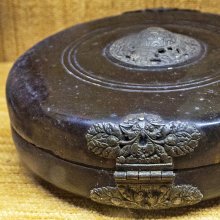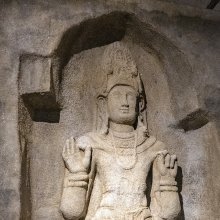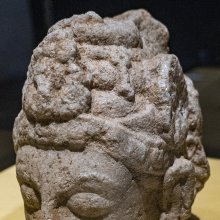Valin, Vālin: 7 definitions
Introduction:
Valin means something in Hinduism, Sanskrit, Jainism, Prakrit, Buddhism, Pali. If you want to know the exact meaning, history, etymology or English translation of this term then check out the descriptions on this page. Add your comment or reference to a book if you want to contribute to this summary article.
Images (photo gallery)
(+9 more images available)
In Hinduism
Purana and Itihasa (epic history)
Source: Archaeological Survey of India: Śaiva monuments at Paṭṭadakal (rāmāyaṇa)1) Vālin (वालिन्) and Sugrīva were the two sons of Ahalyā, wife of Gautama ṛṣi. Without the knowledge of her ascetic husband, she conceived secretly and gave birth to two sons, Vālin the elder by Indra and Sugrīva the younger by Sūrya. Tārā was the most beloved wife of Vālin and Aṅgada a fruit of their union.
2) Vālin (वालिन्).—In the Tattvasaṃgraha Rāmāyaṇa, the story is that Vālin, monkey king of unmatched energy, son of Ahalyā and Indra, went to the spot where the churning of the ocean was going on. On seeing the fatigue of gods, Viṣṇu requested Indra to persuade his son to help the gods in their act. When Indra did accordingly, Viṣṇu decorated the Monkey King Vālin with a necklace of divine golden lotuses and showered upon him many blessings amongst which one was that he will be always invincible in duels because half of the energy of his adversary will go to him. Filled with joy with such unexpected honours, Vālin took both ends of the snake to agitate the mountain. (Tattvasaṃgraha Rāmāyaṇa, Kiṣkindhā-khaṇḍa, 5)

The Purana (पुराण, purāṇas) refers to Sanskrit literature preserving ancient India’s vast cultural history, including historical legends, religious ceremonies, various arts and sciences. The eighteen mahapuranas total over 400,000 shlokas (metrical couplets) and date to at least several centuries BCE.
In Jainism
General definition (in Jainism)
Source: archive.org: TrisastisalakapurusacaritraVālin (वालिन्) refers to one of the sons of Ādityarajas and Indumālinī, according to the Jain Ramayana and chapter 7.2 [Rāvaṇa’s expedition of conquest] of Hemacandra’s 11th century Triṣaṣṭiśalākāpuruṣacaritra: an ancient Sanskrit epic poem narrating the history and legends of sixty-three illustrious persons in Jainism.
Accordingly, “Now, a son was borne to Ādityarajas, the king of the Kapis, by his chief-queen Indumālinī, named Vālin, powerful. Vālin, abundantly endowed with strength of arm, constantly circumambulating Jambūdvīpa bounded by the ocean, paid homage to all the shrines. There was another son of Ādityarajas, Sugrīva, and a younger daughter, Suprabhā. [....] King Ādityarajas gave his kingdom to Vālin, powerful, became a mendicant, and reached emancipation, after practicing penance. Vālin made Sugrīva heir-apparent, who possessed right-belief, knew the law, was compassionate, powerful, like himself”.

Jainism is an Indian religion of Dharma whose doctrine revolves around harmlessness (ahimsa) towards every living being. The two major branches (Digambara and Svetambara) of Jainism stimulate self-control (or, shramana, ‘self-reliance’) and spiritual development through a path of peace for the soul to progess to the ultimate goal.
Languages of India and abroad
Pali-English dictionary
Source: Sutta: The Pali Text Society's Pali-English DictionaryVālin, (adj.) (fr. vāla1) having a hairy tail Vv 647, cp. VvA. 277. (Page 610)
— or —
Valin, (adj.) (fr. vali) having wrinkles M. I, 88 (Acc. palitakesiṃ vilūnaṃ khalita-siraṃ valinaṃ)=III, 180 (palitakesaṃ vilūnaṃ khalitaṃ-siraṃ valīnaṃ etc.) See valita for this passage.—In compn vali-mukha “wrinkled face, ” i.e. monkey J. II, 298. (Page 603)

Pali is the language of the Tipiṭaka, which is the sacred canon of Theravāda Buddhism and contains much of the Buddha’s speech. Closeley related to Sanskrit, both languages are used interchangeably between religions.
Sanskrit dictionary
Source: Cologne Digital Sanskrit Dictionaries: Cappeller Sanskrit-English DictionaryVālin (वालिन्).—(having hair or a tail); [Name] of of a Daitya & a monkey.
Source: Cologne Digital Sanskrit Dictionaries: Monier-Williams Sanskrit-English Dictionary1) Vālin (वालिन्):—[from vāla] m. (also written bālin) ‘haired or tailed’, Name of a Daitya, [Mahābhārata]
2) [v.s. ...] of a monkey (son of Indra and elder brother of the monkey-king Su-grīva, during whose absence from Kiṣkindha Vālin usurped the throne, but when Su-grīva returned he escaped to Ṛṣyamūka), [Mahābhārata; Rāmāyaṇa] etc.
Source: DDSA: Paia-sadda-mahannavo; a comprehensive Prakrit Hindi dictionary (S)Valin (वलिन्) in the Sanskrit language is related to the Prakrit words: Vaṃphi, Vāli.
[Sanskrit to German]
Sanskrit, also spelled संस्कृतम् (saṃskṛtam), is an ancient language of India commonly seen as the grandmother of the Indo-European language family (even English!). Closely allied with Prakrit and Pali, Sanskrit is more exhaustive in both grammar and terms and has the most extensive collection of literature in the world, greatly surpassing its sister-languages Greek and Latin.
See also (Relevant definitions)
Starts with: Vali-nataicelavu, Vali-nataipatam, Valimda, Valina, Valinaka, Valinal, Valinata, Valinatai, Valinatai-k-itumpanam, Valinci, Valindra, Valini, Valinil, Valinilai, Valinilaikkatci, Valinkam, Valinoy, Valintotu, Valintukol, Valinul.
Ends with: Ayogikevali, Ekajvali, Govalin, Jvalin, Kevalin, Sayogikevali, Sevalin, Shadvalin, Shaivalin, Shrutakevalin, Vidyujjvalin, Vihvalin.
Full-text (+21): Vali, Dundubhidarpahan, Sugriva, Shakrasuta, Riksharajas, Indraja, Kishkindha, Aindri, Vasavi, Vamphi, Samkrandani, Pettaimari, Indrasunu, Valini, Punniyanir, Valisambhava, Valihantri, Kishkindhadhipa, Govalin, Samkrandananandana.
Relevant text
Search found 8 books and stories containing Valin, Vālin; (plurals include: Valins, Vālins). You can also click to the full overview containing English textual excerpts. Below are direct links for the most relevant articles:
Trishashti Shalaka Purusha Caritra (by Helen M. Johnson)
Part 2: Sāhasagati as a false Sugrīva < [Chapter VI - Bringing news of Sītā]
Part 5: Further exploits of Rāvaṇa < [Chapter II - Rāvaṇa’s expedition of Conquest]
Introduction to volume 4 < [Introductions]
The Padma Purana (by N.A. Deshpande)
Chapter 107 - Vīrabhadra’s Heroic Deed < [Section 5 - Pātāla-Khaṇḍa (Section on the Nether World)]
Chapter 116 - Narration of the Rāmāyaṇa of a Former Kalpa < [Section 5 - Pātāla-Khaṇḍa (Section on the Nether World)]
Chapter 61 - Glorification of Tulasī < [Section 1 - Sṛṣṭi-khaṇḍa (section on creation)]
The Agni Purana (by N. Gangadharan)
Chapter 8 - Manifestation of Viṣṇu as Rāma (part 4)
Kuntaka’s evaluation of Sanskrit literature (by Nikitha. M)
9. Udāttarāghava in Kuntaka’s treatment < [Chapter 4 - Kuntaka’s evaluation of Sanskrit Plays of other Poets]
Conclusion to Chapter 4 < [Chapter 4 - Kuntaka’s evaluation of Sanskrit Plays of other Poets]
Tragic Potentialities of Bhavabhuti < [April – June, 1984]
Mimamsa interpretation of Vedic Injunctions (Vidhi) (by Shreebas Debnath)





